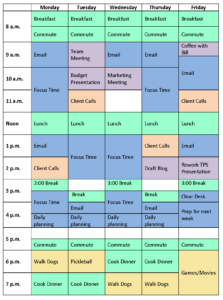
While calendars can be traced back to ancient Babylonia, appointment calendars for personal and professional use are a more recent innovation. Today, calendars can take many forms, from shared digital schedules to more traditional paper planners. When distractions are just a click away, the art of time management has become a critical skill for maintaining productivity. One effective method that has gained popularity among busy professionals is time blocking. This approach not only helps organize daily tasks but also can have a significant impact on productivity.
What Is Time Blocking?
Time blocking is a time management technique that involves dividing days into defined blocks of time, each dedicated to a specific task or group of tasks. Cal Newport, who is credited with coining the term, says he dedicates 20 minutes at the end of every day to plan his schedule for the next day. “This type of planning, to me, is like a chess game,” Newport says, “with blocks of work getting spread and sorted in such a way that projects big and small all seem to click into completion with (just enough) time to spare.” Benjamin Franklin used an earlier form of time blocking, scheduling his day hour by hour, including time to eat, read, tidy up, and even relax.
Unlike traditional to-do lists, which often lead to multitasking and scattered focus, time blocking requires committing a set period of time to a single task, minimizing interruptions and facilitating deeper work.
The Impact of Time Blocking on Productivity
According to research conducted at the University of California, Irvine, it takes an average of 23 minutes and 15 seconds to regain focus after an interruption. By allocating blocks of time for focused work and limiting distractions, time blocking reduces the likelihood of such interruptions, helping users complete tasks more efficiently. Newport estimates that “a 40-hour time-blocked work week…produces the same amount of output as a 60+ hour work week pursued without structure.”
According to a survey by the project management tool Asana, 80 percent of knowledge workers say they feel overworked. RescueTime reports that only 10 percent of people feel “in control” of how they spend their day. Time blocking proponents say the method fosters a greater sense of control over one’s schedule thanks to enhanced organization, more balanced priorities, reduced procrastination, and stronger boundaries with co-workers regarding their availability.
Managing Email Urgency with Time Blocking
Emails are one of the biggest drains on productivity. The constant influx of emails can create a false sense of urgency, leading to frequent task-switching and diminished productivity. By scheduling specific times to check and respond to emails, time blocking helps mitigate the stress associated with email overload.
According to his New York Times article, “The Tyranny of Email Urgency,” Newport, says the belief that emails must be answered immediately creates an “endless treadmill” that keeps workers perpetually behind. “This culture of immediacy is a major cause of burnout,” Newport says. By adopting time blocking, professionals can reclaim their time and reduce the psychological toll of email urgency. Newport further suggests that “a more intentional approach to handling email—limiting it to scheduled blocks of time—can restore sanity to our workdays.”
How to Start Time Blocking
Implementing time blocking in your daily routine requires some planning, but the benefits are well worth the effort. Here are a few steps to help you get started:
1. Identify your priorities. Start by determining the most important tasks that require focused time. These should be your top priorities in your schedule.
2. Create a time block schedule. Create a daily and weekly blueprint by dividing your day into blocks, assigning each block to a specific task or group of tasks. Some sample blocks include email review, client calls and/or meetings, internal meetings, lunch, focus time, break, lunch, and exercise. A traditional hourly calendar, free template, or digital tool can help. Be realistic about how much time each task requires and incorporate open slots for unexpected activities or delays. Also, a visual representation can help users plan and stay on track.

3. Limit distractions. During each time block, minimize distractions by turning off notifications, closing unnecessary tabs and applications, silencing your phone, and communicating your schedule to colleagues.
4. Stick to the plan. Consistency is key to the success of time blocking. Stick to your schedule as closely as possible, but also allow flexibility to accommodate unexpected events. Also, keep the calendar visible and make it a habit to check it regularly.
5. Review and adjust. At the end of the day or week, review your schedule and then see what worked and what didn’t. Then, adjust your time blocks as needed to improve efficiency.
Time Management Is a Balancing Act

“Focus time, collaboration time, connection and rest are like the macronutrients of a workday,” says David Ard, senior vice president of employee success at Slack and Salesforce. “The right balance gives you the energy you need to work your best.” Time blocking is more than a time management tool; it’s a strategy for taking control of your workday and enhancing productivity. As an “always on” expectation continues to challenge our ability to stay focused, time blocking offers a practical solution for reclaiming time and improving overall well-being.

